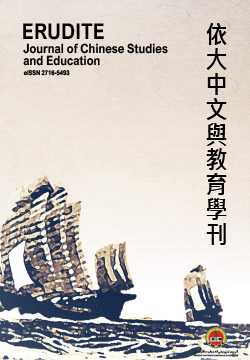怨曲新声: 论华语流行歌曲对传统“闺怨词”的继承与发展
New Voices of The Boudoir Repinings Poems: Research on Chinese Popular Songs’ Inheritance and Development of The Traditional Boudoir Repinings Poems
DOI:
https://doi.org/10.37134/erudite.vol4.1.2.2023Keywords:
闺怨, 诗歌, 歌词, 流行歌曲, 粤语歌曲Abstract
闺怨诗是中国古典诗歌里的常见类别。二十世纪以来,随着女性社会与经济地位的改变,与 “闺怨”相关的文学作品似乎已逐渐淡出人们的视野。于此同时,现当代流行歌坛涌现出大量抒写女性情感和境况的歌曲,以传统或现代的表达方式谱写出与过去相似或新颖另类的闺怨情致。本文从流行歌曲大量涌现的上世纪三十年代开始至本世纪初,选取近百年间由女歌手原唱的,摹写女性怨望心声且具有较高传唱度或代表性的华语流行歌词进行赏析,重点从它们对古典文学的模仿借鉴、古意新词的尝试创新以及闺怨情感延续变迁带来的创作革新等三个方面,探究古今闺怨曲的承袭和流变。可以看到,闺怨题材的文学作品不仅没有淡出人们的视野,反而随着时代的发展不断变化,通过流行歌词呈现出多样化的色彩。新时代的 “闺怨曲”作者们与时偕行,书写、记录下不同阶层、不同身世际遇的女性悲欢离合、感时伤世的心曲,让广大女性从中得到情感的寄托,升华情感认知,这是流行歌曲和古代诗教一脉相承的精神所在。
Boudoir-plaint poetry is a common category in classical Chinese poetry. With the development of women's social and economic status since the 20th century, literary works related to "boudoir-plaint" seem to have gradually faded out, while a large number of songs expressing women's emotions and situations have emerged in the modern and contemporary pop music, conveying similar or novel boudoir plaints in both ancient and modern ways. This article selects several highly representative Chinese pop songs depicting boudoir plaints composed between 1930 when pop songs proliferated and the beginning of 21st century that were originally sung by female singers in the past 100 years. In order to explore the inheritance and innovation of the Boudoir-plaints poetry over this period, lyrics will be analyzed in following three aspects, their reference and heritage of classical literature, the continuation and change of boudoir plaints, and the innovation and expansion in composition. It shows that the literary works about boudoir plaints not only did not fade out, but moved with the times, demonstrating a great diversity across time. The boudoir-plaint poets of the new era walk with the times, writing down the joys and sorrows of women of different social strata and life experiences, providing emotional sustenance and cognition for them, contributing to their temperamental refinement and self-cultivation. In this way, the spirit of the ancient poetry is inherited by modern pop songs.
Keywords: Boudoir, Poetry, Lyrics, Modern Popular Songs, Cantonese songs
Downloads
References
一、著作
王廷绍编订,颜自德辑,《霓裳续谱》,清乾隆六十年(1795)版。
王实甫著,张燕瑾校注,《西厢记》,北京:人民文学出版社,2022。
王丽慧,《歌声中的文学》,上海:上海社会科学院出版社,2003。
中国社会科学院语言研究所词典编辑室编,《现代汉语词典(第7版)》,北京:商务印书馆,2016。
中国戏曲研究院编,《中国古典戏曲论著集成》,北京:中国戏剧出版社,1982。
尤静波,《中国流行音乐通论》,北京:大众文艺出版社,2008。
司马迁著,泷川资言会注考证,《史记会注考证(高清印复印件)》,北京:新世界出版社,2009。
布罗茨基(Brodsky,Joseph),刘文飞译,《文明的孩子》(Children of Civilization),北京:中央编译出版社,2007。
朱耀伟,《香港粤语流行歌词研究I》,香港:亮光文化有限公司Enlighten&Fish Ltd,2011。
何文焕辑,《历代诗话》,北京:中华书局,2001。
宋秋敏,《唐宋词与流行歌曲》,北京:中国社会科学出版社,2009。
李清照著,李月,张敏鹏编校,《李清照词集》,北京:民族出版社,2004。
李剑国辑校,《唐五代传奇集》,上海:上海古籍出版社,2015。
班固,《汉书》,北京:中华书局,2002。
郭茂倩编,《乐府诗集》,北京:中华书局,2013。
许慎,《说文解字(附检字)》,北京:中华书局,2009。
刘勰著,范文澜注,《文心雕龙注》,北京:人民文学出版社,2000。
台湾商务印书馆编辑委员会,《增修辞源》,台北:台湾商务印书馆,1978。
郑玄笺,孔颖达疏,《唐宋注疏十三经》,北京:中华书局,1998。
鲁迅,《鲁迅小说全编(插图本)》,桂林:漓江出版社,2002。
橘君辑注,《冯梦龙诗文》,福州:海峡文艺出版社,1985。
钟嵘著,吕德申校著,《诗品》,北京:北京大学出版社,1986。
二、论文
黄霑,<粤语流行曲的发展与兴衰 : 香港流行音樂研究 ( 1949 - 1997 )>,香港,香港大学博士论文,2003。
庄妙菁,<“华语”一词的历史演变与发展>,柔佛,南方学院华人族群与文化研究所,2005。
施咏,<什么是 “中国流行音乐”—— “流行音乐民族化”视野下的概念辨析>,《中国音乐》,2016年第3期,页100-104,195。
(三)电子资料
OpenRice开饭喇,风传媒转载,〈美酒加咖啡,不只喝一杯!台湾星巴克领先全球独创“咖啡啤酒”,连美国都还喝不到〉(2017,Jan. 6),Retrieved Nov. 23, 2022, from http://bsm.org.cn/show_article.php?id=1986 。
YouTube,李宗盛、马世芳对谈:<今晚请将耳朵借我>(2014年6月25日晚上7:30-9:00),台北信义学堂,https://www.youtube.com/watch?v=aLxxfzfkwzc。
Downloads
Published
How to Cite
Issue
Section
License
Copyright (c) 2023 Yi Wang, Wue Hiong Ser

This work is licensed under a Creative Commons Attribution-NonCommercial-ShareAlike 4.0 International License.





